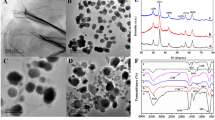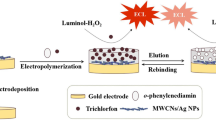Abstract
The gradual emissions of tetrabromobisphenol A (TBBPA) from the primitive recycling of E-waste create human health threats, which urgently require to develop an efficient, rapid yet simple detection method. The present study conducts a highly sensitive molecularly imprinted photoelectrochemical sensor (MIPES) containing molecularly imprinted (MI)-TiO2, Au, and reduced graphene oxide for the trace detection of TBBPA in indoor dust and surface water from an E-waste recycling area. The photocurrent response is used to evaluate the sensing performance of the MIPES toward TBBPA detection. The working potential for amperometry is 0.48 V. The wavelength range for photoelectrochemical detection is 320–780 nm. The sensor shows a detection range of 1.68 to 100 nM with a low limit of detection of 0.51 nM (LOD = 3 sb/S) and a limit of quantification of 1.68 nM (LOQ = 3.3 LOD). In addition, the MIPES sensor exhibits rapid, excellent reproducibility, selectivity, and long-term stability toward TBBPA detection. The relative standard deviation of three measurements for real samples is less than 7.0%, and the recovery range is 90.0–115%. The surface of molecular imprinting contributes to the high charge separation and sensing photocurrent response of TBBPA, which is confirmed by single-particle photoluminescence spectroscopy. The present study provides a new facile sensor with highly sensitive yet rapid response to detect environmental pollutants in E-waste by using the MIPES.
Graphical abstract









Similar content being viewed by others
References
Liu K, Li J, Yan S, Zhang W, Li Y, Han D (2016) A review of status of tetrabromobisphenol A (TBBPA) in China. Chemosphere 148:8–20
Guo Y, Zhou J, Lou X, Liu R, Xiao D, Fang C, Wang Z, Liu J (2014) Enhanced degradation of tetrabromobisphenol A in water by a UV/base/persulfate system: kinetics and intermediates. Chem Eng J 254:538–544
Pivnenko K, Granby K, Eriksson E, Astrup TF (2017) Recycling of plastic waste: screening for brominated flame retardants (BFRs). Waste Manag 69:101–109
Mäkinen MS, Mäkinen MR, Koistinen JT, Pasanen A-L, Pasanen PO, Kalliokoski PJ, Korpi AM (2009) Respiratory and dermal exposure to organophosphorus flame retardants and tetrabromobisphenol A at five work environments. Environ Sci Technol 43(3):941–947
Wang J, Liu L, Wang J, Pan B, Fu X, Zhang G, Zhang L, Lin K (2015) Distribution of metals and brominated flame retardants (BFRs) in sediments, soils and plants from an informal e-waste dismantling site, South China. Environ Sci Pollut Res 22(2):1020–1033
Morris S, Allchin CR, Zegers BN, Haftka JJ, Boon JP, Belpaire C, Leonards PE, Van Leeuwen SP, De Boer J (2004) Distribution and fate of HBCD and TBBPA brominated flame retardants in North Sea estuaries and aquatic food webs. Environ Sci Technol 38(21):5497–5504
Robinson BH (2009) E-waste: an assessment of global production and environmental impacts. Sci Total Environ 408(2):183–191
Strack S, Detzel T, Wahl M, Kuch B, Krug HF (2007) Cytotoxicity of TBBPA and effects on proliferation, cell cycle and MAPK pathways in mammalian cells. Chemosphere 67(9):S405–S411
Darnerud PO (2003) Toxic effects of brominated flame retardants in man and in wildlife. Environ Int 29(6):841–853
Eriksson P, Jakobsson E, Fredriksson A (2001) Brominated flame retardants: a novel class of developmental neurotoxicants in our environment? Environ Health Persp 109(9):903–908
Hu S, Yu Y, Guan Y, Li Y, Wang B, Zhu M (2020) Two-dimensional TiO2 (001) nanosheets as an effective photo-assisted recyclable sensor for the electrochemical detection of bisphenol A. Chinese Chem Lett 31:2839–2842
Li Z, Zhu M (2020) Detection of pollutants in water bodies: electrochemical detection or photo-electrochemical detection? Chem Commun 56:14541–14552
Meteku BE, Huang J, Zeng J, Subhan F, Feng F, Zhang Y, Qiu Z, Aslam S, Li G, Yan Z (2020) Magnetic metal–organic framework composites for environmental monitoring and remediation. Coordin Chem Rev 413:213261
Wang C, Du J, Wang H, Zou CE, Jiang F, Yang P, Du Y (2014) A facile electrochemical sensor based on reduced graphene oxide and Au nanoplates modified glassy carbon electrode for simultaneous detection of ascorbic acid, dopamine and uric acid. Sensor Actuat B: Chem 204:302–309
Jiang T, Sun X, Wei L, Li M (2020) Determination of hydrogen peroxide released from cancer cells by a Fe-organic framework/horseradish peroxidase-modified electrode. Anal Chim Acta 1135:132–141
Shang H, Xu H, Jin L, Wang C, Chen C, Song T, Du Y (2020) 3D ZnIn2S4 nanosheets decorated ZnCdS dodecahedral cages as multifunctional signal amplification matrix combined with electroactive/photoactive materials for dual mode electrochemical–photoelectrochemical detection of bovine hemoglobin. Biosens Bioelectron 159:112202
Li Z, Zhang H, Zha Q, Zhai C, Li W, Zeng L, Zhu M (2020) Photo-electrochemical detection of dopamine in human urine and calf serum based on MIL-101 (Cr)/carbon black. Microchim Acta 187(9):1–9
Li Z, Hu J, Xiao Y, Zha Q, Zeng L, Zhu M (2021) Surfactant assisted Cr-metal organic framework for the detection of bisphenol A in dust from E-waste recycling area. Anal Chim Acta 1146:174–183
Chen X, Ji L, Zhou Y, Xia S, Tong J, Wu K (2016) Electrochemical enhancement of long alkyl-chained surfactants for sensitive determination of tetrabromobisphenol A. Electrochim Acta 190:490–494
Zhao Q, Zhang K, Yu G, Wu W, Wei X, Lu Q (2016) Facile electrochemical determination of tetrabromobisphenol A based on modified glassy carbon electrode. Talanta 151:209–216
Ding S, Lyu Z, Niu X, Zhou Y, Liu D, Falahati M, Du D, Lin Y (2020) Integrating ionic liquids with molecular imprinting technology for biorecognition and biosensing: a review. Biosens Bioelectron 149:111830
Gao P, Wang H, Li P, Gao W, Zhang Y, Chen J, Jia N (2018) In-site synthesis molecular imprinting Nb2O5–based photoelectrochemical sensor for bisphenol A detection. Biosens Bioelectron 121:104–110
Hu J, Zhai C, Zhu M (2021) Photo-responsive metal/semiconductor hybrid nanostructure: a promising electrocatalyst for solar light enhanced fuel cell reaction. Chinese Chem Lett 32:1348–1358
Zhao W-W, Xu J-J, Chen H-Y (2016) Photoelectrochemical detection of metal ions. Analyst 141(14):4262–4271
Wang G, Xu J, Chen H (2009) Progress in the studies of photoelectrochemical sensors. Sci China Ser B 52(11):1789–1800
Pei D-N, Zhang A-Y, Pan X-Q, Si Y, Yu H-Q (2018) Electrochemical sensing of bisphenol A on facet-tailored TiO2 single crystals engineered by inorganic-framework molecular imprinting sites. Anal Chem 90(5):3165–3173
Chen K, Liu M, Zhao G, Shi H, Fan L, Zhao S (2012) Fabrication of a novel and simple microcystin-LR photoelectrochemical sensor with high sensitivity and selectivity. Environ Sci Technol 46(21):11955–11961
Liu M, Ding X, Yang Q, Wang Y, Zhao G, Yang N (2017) A pM leveled photoelectrochemical sensor for microcystin-LR based on surface molecularly imprinted TiO2@ CNTs nanostructure. J Hazard Mater 331:309–320
Wang C, Ye X, Wang Z, Wu T, Wang Y, Li C (2017) Molecularly imprinted photo-electrochemical sensor for human epididymis protein 4 based on polymerized ionic liquid hydrogel and gold nanoparticle/ZnCdHgSe quantum dots composite film. Anal Chem 89(22):12391–12398
Sun X, Gao C, Zhang L, Yan M, Yu J, Ge S (2017) Photoelectrochemical sensor based on molecularly imprinted film modified hierarchical branched titanium dioxide nanorods for chlorpyrifos detection. Sensor Actuat B: Chem 251:1–8
Viter R, Kunene K, Genys P, Jevdokimovs D, Erts D, Sutka A, Bisetty K, Viksna A, Ramanaviciene A, Ramanavicius A (2020) Photoelectrochemical bisphenol S sensor based on ZnO-nanoroads modified by molecularly imprinted polypyrrole. Macromol Chem Phys 221(2):1900232
Wang C, Wang Y, Zhang H, Deng H, Xiong X, Li C, Li W (2019) Molecularly imprinted photoelectrochemical sensor for carcinoembryonic antigen based on polymerized ionic liquid hydrogel and hollow gold nanoballs/MoSe2 nanosheets. Anal Chim Acta 1090:64–71
Leong S, Razmjou A, Wang K, Hapgood K, Zhang X, Wang H (2014) TiO2 based photocatalytic membranes: a review. J Membrane Sci 472:167–184
Sharabi D, Paz Y (2010) Preferential photodegradation of contaminants by molecular imprinting on titanium dioxide. Appl Catal B Environ 95(1–2):169–178
Hu L, Fong C-C, Zhang X, Chan LL, Lam PK, Chu PK, Wong K-Y, Yang M (2016) Au nanoparticles decorated TiO2 nanotube arrays as a recyclable sensor for photoenhanced electrochemical detection of bisphenol A. Environ Sci Technol 50(8):4430–4438
Shen B, Zhai W, Zheng W (2014) Ultrathin flexible graphene film: an excellent thermal conducting material with efficient EMI shielding. Adv Funct Mater 24(28):4542–4548
Manohar AK, Bretschger O, Nealson KH, Mansfeld F (2008) The use of electrochemical impedance spectroscopy (EIS) in the evaluation of the electrochemical properties of a microbial fuel cell. Bioelectrochemistry 72(2):149–154
Yang X, Fu H, Wang W, Xiong S, Han D, Deng Z, An X (2020) Enhanced solar light photocatalytic performance based on a novel Au-WO3@TiO2 ternary core–shell nanostructures. Appl Surf Sci 505:144631
Zhu M, Zhai C, Kim S, Fujitsuka M, Majima T (2019) Monitoring transport behavior of charge carriers in a single CdS@ CuS nanowire via in situ single-particle photoluminescence spectroscopy. J Phys Chem Lett 10(14):4017–4024
Li X, Bi W, Zhang L, Tao S, Chu W, Zhang Q, Luo Y, Wu C, Xie Y (2016) Single-atom Pt as co-catalyst for enhanced photocatalytic H2 evolution. Adv Mater 28(12):2427–2431
Fang Y, Jiao Y, Xiong K, Ogier R, Yang Z-J, Gao S, Dahlin AB, Kall M (2015) Plasmon enhanced internal photoemission in antenna-spacer-mirror based Au/TiO2 nanostructures. Nano Lett 15(6):4059–4065
Radoi A, Compagnone D, Devic E, Palleschi G (2007) Low potential detection of NADH with Prussian Blue bulk modified screen-printed electrodes and recombinant NADH oxidase from Thermus thermophilus. Sensor Actuat B: Chem 121(2):501–506
Funding
This work has been supported by the Guangdong Basic and Applied Basic Research Foundation (No. 2020B1515020038) and the Pearl River Talent Recruitment Program of Guangdong Province (2019QN01L148).
Author information
Authors and Affiliations
Corresponding author
Ethics declarations
Conflict of interest
The authors declare that they have no competing of interests.
Additional information
Publisher’s note
Springer Nature remains neutral with regard to jurisdictional claims in published maps and institutional affiliations.
Supplementary information
ESM 1
(DOC 2591 kb)
Rights and permissions
About this article
Cite this article
Li, Z., Hu, J., Lou, Z. et al. Molecularly imprinted photoelectrochemical sensor for detecting tetrabromobisphenol A in indoor dust and water. Microchim Acta 188, 320 (2021). https://doi.org/10.1007/s00604-021-04980-1
Received:
Accepted:
Published:
DOI: https://doi.org/10.1007/s00604-021-04980-1




